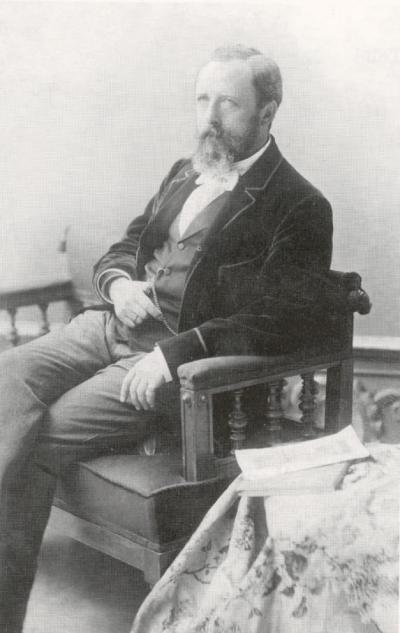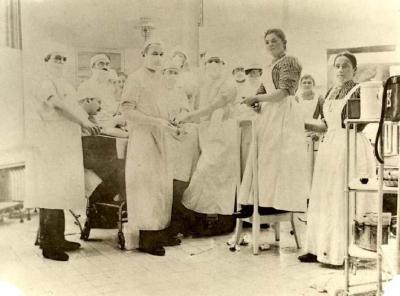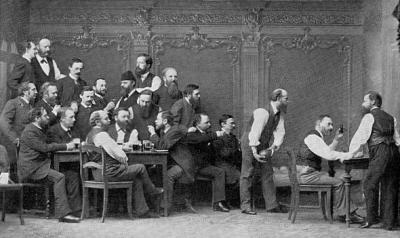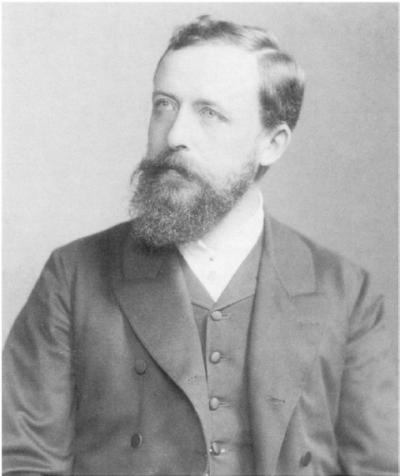Jan Mikulicz-Radecki (1850-1905) – The forgotten surgical genius
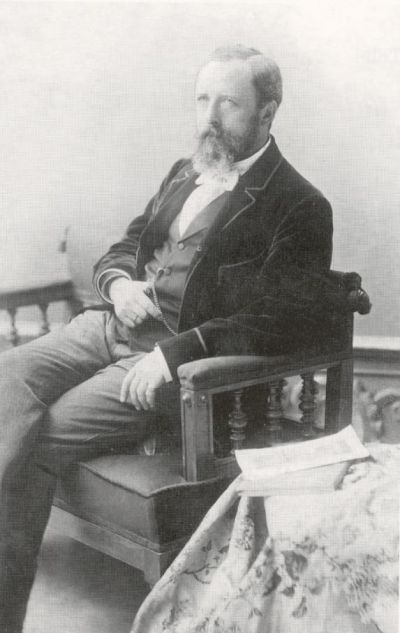
Medical students and doctors would probably make the connection between Jan Mikulicz-Radecki and a surgical procedure or with a medical instrument they generally use in surgery, the so-called Mikulicz clamp. But not much is known about the man. His biography, however, reflects the complicated history of Central Europe in the second half of the 19th century.
Jan Anton von Mikulicz-Radecki was born in 1850 in Czernowitz, the capital of Bukovina, which at that time was part of the Austrian Empire. His father was a Pole from an old Polish noble family, his mother, Emilia Freiin von Damnitz, was born into Prussian nobility. Jan was the youngest of the couple’s five children (his father had another three children from a previous marriage). “He was small and delicate of stature, had a weak constitution, was taciturn, didn’t push himself to the front”[1] – that is how a biographer described the man who was later to be a surgeon. It was thanks to Bukovina, the multicultural melting pot in which Poles, Russians, Moldovans, Jews, Germans and Romanians and others lived, that Mikulicz-Radecki learnt several languages as a child, including Polish, German Russian and Yiddish.
When Jan Anton turned eight, his father sent him to Prague with his mother and sisters so that the children could go to schools where the standard was significantly above that of the educational facilities in Czernowitz. After three years there, the family returned to Bukovina, but one year later in 1863 they set off again, this time to Vienna. As a day pupil in the Empire’s metropolis, Mikulicz-Radecki initially attended the Theresianum, an exclusive school founded by Empress Marie Therese to prepare noble young men for the civil service.[2] One year later, he moved to the Benedictine grammar school in Klagenfurt, where his sister had an engagement in the theatre. During this time, Jan, who played the church organ at mass, considered joining an order. His father, Andreas Mikulicz, was vehemently opposed.
[1] Preface to the Polish version by Wojciech Noszczyk, What does an average doctor today know about Jan Mikulicz-Radecki?, [in:] Waldemar Kozuschek, Johann Mikulicz-Radecki 1850-1905. Mitbegründer der modernen Chirurgie, bilingual edition: Polish German, Wydawnictwo Uniwersytetu Wrocławskiego, Wrocław 2005, p. 11.
[2] https://www.theresianum.ac.at/ (retrieved on 10 March 2020).
When his son informed him that he intended to study medicine, he put up an opposition to this too. And although his father saw Jan studying law in the future, this time Jan went against him. As a consequence of his son’s disobedience, Jan’s father refused to provide any more financial support for his education. Despite this, in 1869 he started studying medicine at Vienna University whilst initially earning his living giving private tuition and piano lessons. Not long afterwards, thanks to his professor’s support, he received a scholarship from the Silberstein Foundation which allowed him to devote his full attention to his studies.
In 1875, Mikulicz was awarded a doctorate in Medicine and was accepted into the Vienna Surgical Hospital by Theodor Billroth, who today is considered the father or modern surgery. “By contrast, Billroth’s lectures demonstrated profound knowledge and extensive practice and experience, they were quite simply brilliant. You felt that he was leaving the well trodden paths of surgical practice and entering a new land that had been hitherto inaccessible.“[3] A year after his marriage to the Austrian Henriette Pacher, Jan Mikulicz had to leave his position at the hospital because the rules in force at the time stated that a married assistant could not occupy a permanent post at the university hospital. Mikulicz took over the direction of the surgical polyclinic but was not allowed to carry out any scientific research. A Viennese manufacturer of surgical instruments came to his aid which enabled the young surgeon to develop the so-called Mikulicz gastroscope. In 1881, in a world first, he carried out a procedure in which he was able to provide endoscopic evidence of a carcinoma of the lower oesophagus.[4]
In 1882, Jan Mikulicz, with the support of Theodor Billroth, assumed the Chair of Surgery in Krakow although he was not one of their preferred applicants. The Commission accused him of knowing too little Polish. As a result, his supporter, Billroth, wrote to one of the professors in Krakow as follows: “Just watch Mikulicz operate and you would want him even if he were deaf and dumb.”[5] For his part, Mikulicz prepared diligently to take over the Chair by improving his Polish. His appointment was only reluctantly accepted by the medical circles in Krakow because they felt that his sponsorship had come from Vienna. In his inaugural lecture, at which police were in attendance in the lecture theatre to prevent any protests, the surgeon made reference to this, saying: “I have been accused of not knowing the Polish language although it is my mother tongue just as much as it is that of every man here present. It is true that I neglected our mother tongue due to my long stays at German scientific institutions [...] .”[6] It is difficult to judge today whether this was a statement about his nationality, especially because when asked whether he was a Pole, a German or an Austrian, Mikulicz generally answered: “I am a surgeon”.
[3] Der Schüler von Billroth, [in:] Kozuschek, Johann Mikulicz-Radecki..., p. 55.
[4] Ibid, p. 73.
[5] Letters from Theodor Billroth, p. 171, cited from: Kozuschek, Johann Mikulicz-Radecki..., p. 81.
[6] Jan Mikulicz, O wpływie chirurgii nowoczesnej na kształcenie uczniów w klinice chirurgicznej, [in:] Przegląd Lekarski, No. 43, p. 569-572. Cited from: Hans-Detlev Saeger u.a. (Publ.), Chirurgisches Forum 2006 für Experimentelle und Klinische Forschung: Berlin, 02.05. -05.05.2006, Vol. 35, Conference Paper, Springer Medizin Verlag, Heidelberg 2006, p. IX.
In any case, under the direction of Jan Mikulicz the Krakow Hospital developed rapidly and was ultimately considered the best in the Empire. It was also sought out by doctors from Austria who as scholars wanted to deepen their knowledge of surgery. In spite of his high professional standing, Mikulicz was unable to realise his greatest dream of building a new hospital in Krakow. For this reason, he did not hesitate when it was suggested to him that he take up the surgical Chair in Königsberg. He began his appointment in 1887. Behind this decision, however, was also his secret plan to take up the Chair in Berlin or in Vienna in the future. “For him as a Pole, the prospect of such a call was rather slim. However, he believed that such an opportunity would open up to him if he switched to a German university beforehand.”[7] But what Mikulicz had not anticipated was the reaction of the Austrian government to the step he had taken. The Ministry of Science and Culture of the Monarchy informed him that he would never be allowed to return to Austria for work if he should take up the call to work in Königsberg.
At this time, the facilities in the surgical hospital at the Albertus University in Königsberg were better than those in the hospital in Krakow, even if they did not have an operating theatre and the procedures were carried out in the lecture theatre into which the patients were carried. In Königsberg, Mikulicz mainly focused on surgery of the abdominal cavity. He worked among other things on modifying stomach resections and he described symptoms which would later be referred to as Mikulicz syndrome. From a scientific perspective, Mikulicz’s three years in Königsberg were extremely fruitful, but the most important period of his outstanding career was yet to come.
In 1890, Jan Mikulicz was appointed Director of the newly constructed surgical hospital in Wroclaw. However, before he started in this position, he had to sign a declaration of undertaking that he would not leave the Prussian territory for at least five years. At this point, the hospital building, which was being built in line with the latest scientific insights, had not yet been completed. This meant that the new director was able to bring in his own ideas, especially when it came to the operating theatre. In the years that followed, this was upgraded several times until in 1897 Wroclaw had a completely sterile surgical wing which, at the time, was considered the largest and most state-of-the-art in Europe. Four years later, the hospital, under the direction of the Polish surgeon, was extended to include an orthopaedic department and a physiotherapy room. In 1899, Mikulicz also opened a private hospital which met the latest medical standards.
[7] Lehrstuhlinhaber in Krakau, [in:] Kozuschek, Johann Mikulicz-Radecki..., p. 91 and 93.
The Jews that came from Poland, Russia and Galicia showed particular confidence in Jan Mikulicz and had a special affection for him which almost bordered on admiration. That almost certainly had to do with the fact that he spoke Yiddish and it is evidence of just how great the surgeon’s authority was. “They considered him almost a saint who had a special divine grace. Just the touch of his clothes could bring about healing. (…) The Jews that revered him like to say amongst themselves: First in line is the Lord and then Professor Mikulicz.”[8]
Professor Jan von Mikulicz-Radecki was also held in high esteem abroad. In 1903, at the invitation of the American scientists, he travelled to America to perform exhibition operations, to give lectures and to receive an honorary doctorate in Philadelphia. The high standing of the Wroclaw School of Surgery under his direction is evidenced by the doctors from around the world, including America, England and Japan, who trained there. At the time, Wroclaw was a training ground for many excellent surgeons who then went on to work in hospitals throughout Europe. The best known of Jan Mikulicz’s pupils was Ferdinand Sauerbruch, who also became known for the operations he performed in Wroclaw on open chests with a vacuum chamber, as well as for being the inventor of hand and lower leg prostheses for amputees. Later, Sauerbruch went on to head up the surgical department at Berlin’s Charité hospital for many years. In Germany, he is considered the most important person in medical history.
Jan Mikulicz’s professional plans were thwarted by cancer. In the knowledge that he was soon to die, the brilliant surgeon worked almost until he took his last breath. Shortly before his death, he wrote to his friend Professor Eiselsberg in Vienna: “I depart this life fulfilled and without resentment. I have worked what I was able to and have enjoyed much recognition for it and I was fortunate.”[9] Professor Mikulicz died on 14 June 1905 at the age of 55. On the occasion of his funeral, thousands of people from Wroclaw lined the street to farewell him. At Mikulicz’s request, he was buried in the cemetery in Świebodzice.
Professor Mikulicz’s life’s work is virtually unknown today despite his great accomplishments in medicine or people do not make the connection to him. This may be because Mikulicz gave inconclusive information about his nationality or because Germans at the time considered him to be a Pole and the Poles considered him almost German.[10] The fact that he was greatly respected in his day is also evidenced by the following statement made by Professor Hermann Küttner, his successor at the Chair for Surgery in Wroclaw: “Men, who like Jan von Mikulicz open new doors with the original force of science, who are a godsend to generations of people that come after them – such men are irreplaceable. Of all living surgeons, Mikulicz has made the biggest contribution to surgical progress in the world.”[11]
Monika Stefanek, March 2020
[8] Auf dem Höhepunkt der Karriere in Breslau, [in:] Kozuschek, Johann Mikulicz-Radecki..., p. 121.
[9] From the letter to Prof. Anton von Eiselsberg dated 10 June 1905, cited from: Auf dem Höhepunkt der Karriere in Breslau..., [in:] Kozuschek, Johann Mikulicz-Radecki..., p. 131.
[10] Auf dem Höhepunkt der Karriere in Breslau..., [in:] Kozuschek, Johann Mikulicz-Radecki..., p. 141.
[11] Ibid, p. 143.
